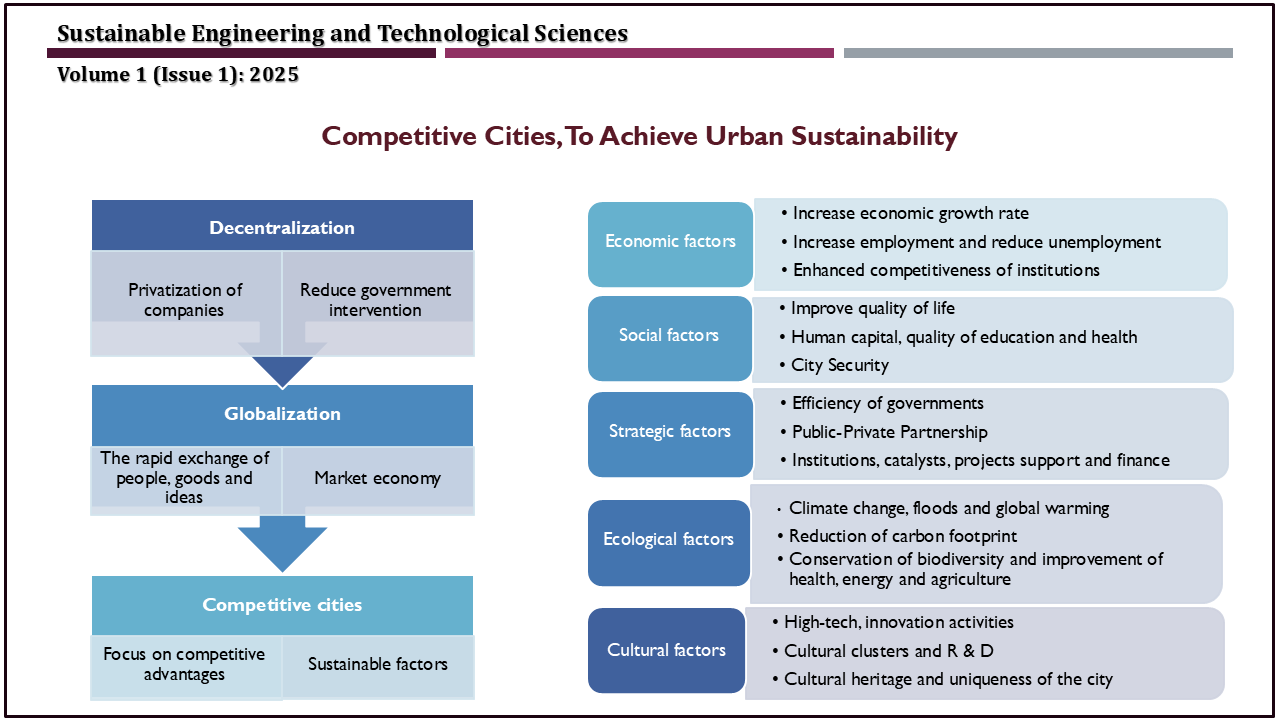Competitive Cities, To Achieve Urban Sustainability
DOI:
https://doi.org/10.70516/ztwhtr80Keywords:
Competitive Cities, Competitiveness, Cultural Heritage, SustainabilityAbstract
This article aims to identify the concept of competitive cities, their most important indicators and to prove the research hypothesis that sustainability plays a major role in enhancing competitive cities by improving the quality of life. The article adopts the descriptive analytical approach by examining three mini-studies, as one of the most competitive cities in the world. Studying the adopted competitive factors and the importance of cultural heritage in the city’s competitiveness. One of the most important results is that cultural heritage has become one of the basic concepts of the city’s competitiveness. It is believed that cultural policy has a major role in promoting tourism and improving local image and identity. Through studying three cases, the research reached some indicators of competitiveness, namely economic, tourism, cultural, social, and urban indicators. Authenticity works to create a close link between competitiveness and the cultural heritage of the city, as urban sustainability can be achieved by improving the quality of life and creating job opportunities through investment in distinguished architectural works. The article examines the importance of cultural heritage and its consideration as an essential indicator in enhancing the competitiveness of cities by studying cases of global competitive cities.
Downloads
References
OECD Territorial Reviews Competitive Cities, “ A New Entrepreneurial Paradigm in Spatial Development ”, Organisation For Economic Co-Operation And Development, This work is published on the responsibility of the Secretary-General of, the OECD, 2007,pp.22-30.
Nompumelelo Q. Thwala: “The Creation of Competitive Cities in South Africa: The Case of The West Rand Vision 2016”, A research report submitted to the Faculty of Engineering and the Built Environment, of the University of the Witwatersrand, Johannesburg, in partial fulfilment of the requirements for the degree of Master of Science in Development Planning. Johannesburg, 2014, pp. 2-4.
Webster, D. and L, Muller. : “Urban Competitiveness Assessment in Developing Country”, Urban Regions: The Road Forward. Washington, DC: World Bank, 2000, p.47.
Ahmed, Muna Mohammed Nafi': “Cultural Heritage as a Policy for Competitive Cities”. 2023 Conference: 8th engineering and 2nd international conference for college of engineering – university of baghdad: coec8-2021 Proceedings. March 2023.AIP Conference Proceedings 2651(1): 020070. DOI: 10.1063/5.0107627 DOI: https://doi.org/10.1063/5.0107627
WEF: World Economic Forum, “The Competitiveness of Cities, A report of the Global Agenda Council on Competitiveness”, REF 040814, 2014. P.5.
Al-Sayed ,Muna M.N. & Alanizi Arshad : “Resilient cities to mitigate effects of climate change”. IOP SCINSE, January 2023 IOP Conference Series Earth and Environmental Science 1129(1): 012029. DOI: 10.1088/1755-1315/1129/1/012029, p.6. DOI: https://doi.org/10.1088/1755-1315/1129/1/012029
The World Bank Group: “Competitive Cities for Jobs and Growth, A ’competitive What, Who, and how”, 1818 H Street NW, Washington, DC 20433, Telephone: 202-473-1000, 2015, p.12.
Asian Development Bank: “Competitive Cities, 6 ADB Avenue, Mandaluyong City”, 1550 Metro Manila, Philippines, www.adb.org. , Publication Stock No. 102656, 2015, p.8.
H Ketels, Christian: “Competitiveness Frameworks Review ,An Analysis Conducted for the National Competitiveness Council ” ,Dublin , March 2016, pp.2-8.
Gemmiti, Roberta “Urban Competitiveness, Culture and Tourism. Critical Aspects in Rome Planning Experience”, Università Degli Studi di Roma Roma,2012
APPT: Rome Smart Tourism Guide, “Smart Tourism” project (2011-2013), by the European Commission under the Lifelong Learning Programme (LLP), promoted by the Italian Association of people with Down syndrome (AIPD) , with Down Syndrome Ireland (DSI) and the Portuguese Association of people (APPT21).2013, p.40.
Abdul Raouf, Ali: “Social Integration between the Identity Crisis and the Globalization Trap, Challenges of the Modern Gulf City and its Transformations”, The Second Annual Conference of Social and Human Sciences, Arab Center for Research and Policy Studies, Doha, Qatar, 2013, pp. 26-27.
Matisse, Henri: “World Cities Culture Report, BOP Consulting Editorial Team, Editorial and Content Direction”: Paul Owens, Richard Naylor: 2015, p.30.
Zaidan, Esmat: “The impact of cultural distance on local residents perception of tourism development:The case of Dubai in UAE”,2016 Department of International Aff airs, College of Arts and Science, Qatar University, E-mail: ezaidan@qu.edu.qa, UAE,2016.
Emaar Properties PJSC Skidmore, Owings & Merrill LLP, “Customer Service Kundenservice Service Consommateurs Servicio Al Consumidor”, LEGO GROUP 2011 www.lego.com/service or dial, pp.15-20.
WCCF, “World Cities Cultural Forum:Global leadership on culture in cities”, 2018
Albayan: “Economy/local-market, Factors that stimulate tourism investment in Dubai”,2012, p.4.
Plöger, Jörg: Bilbao City Report, “Centre for Analysis Of Social Exclusion”, An Esrc Research Centre, 2008, pp.18-20.
Bengoetxea, Ibone: Bilbao,Hangzhou “International Congress “Culture: Key to Sustainable Development” Session: 1B “Culture: The role of local governance”, Deputy Mayor of Bilbao and City Councillor of Culture and Education ,2016, pp 3-7.
Bizkaia, Talent Team: “Bilbao, From Industrial Hub to City of Culture and Services”, largest highly professional network connected to Bilbao - Bay of Biscay and the entire Basque Country, Basque Country, 2016.pp 4-18.

Downloads
Published
Issue
Section
Categories
License
Copyright (c) 2024 Dr. Muna M.N. Alsayed, Dr. Arshad Alanizi (Author)

This work is licensed under a Creative Commons Attribution-NonCommercial-NoDerivatives 4.0 International License.
Open Access and Copyright: SETS operates as an open-access journal, making all its articles freely available to everyone. Published content is licensed under the Creative Commons Attribution International Public License (CC BY 4.0). This license allows individuals and organizations to:
- Download, share, distribute, and print full texts of articles
- Reproduce or link to articles in any medium,
While authors retain copyright for their published work on the SETS website, the journal actively promotes and tracks citations to increase recognition for their research.
In essence, CC-BY-4.0 encourages the widest possible dissemination and utilization of published articles as long as written permission and appropriate credit are given to the authors.







